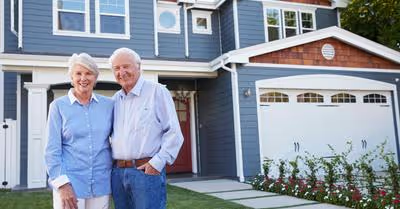Table of Contents
What is Affordable Senior Housing?
Affordable senior housing refers to senior apartments that are subsidized by community, city, state, or federal programs to offer reasonably-priced rents to lower-income senior citizens. The idea here is not just to offer affordable housing to lower-income senior citizens but also to allow them to have money left to pay their other monthly life necessities such as food and healthcare.
While there are many funding sources involved in creating affordable senior housing, the main funders are the U.S. Department of Housing and Urban Development (HUD), Low-Income Housing Tax Credit (LIHTC) program, and the U.S. Department of Agriculture (USDA). Besides funding, some key aspects of affordable senior housing are eligibility, rent subsidy, regulation and licensing, staffing, space, and data.
The Importance of Affordable Senior Housing
With rising debts, decreased earnings, depleted savings, and declining home values, the long term picture for senior citizens is discouraging. As such, an increasing number of older adults are facing the burden of housing costs. Unlike their younger counterparts, senior citizens are more likely to spend over 30% of their income on housing alone. Things become even worse for the poorest seniors who are likely to spend about 50% of their income on housing.
With that in mind, it's easy to see that housing costs place an enormous financial strain on older adults. Affordable senior housing and other federal-assisted programs, therefore, play a vital role in easing these burdens. Some of the potential benefits of affordable senior housing include:
- Affordable senior housing is a great way of preserving senior citizens' independence and autonomy.
- It offers an easier avenue of building and maintaining existing housing and community for senior citizens.
- It helps in providing various health and long-term care policy initiatives such as reduced Medicaid costs, improving care coordination, enhancing service integration, and augmenting delivery systems.
- Affordable senior housing can serve as a haven for service delivery, which can then be extended into neighboring communities to reach even more seniors.
Existing Types of Affordable Senior Housing
Generally, affordable senior housing options are available through four subsidized programs that are either sponsored or supported by the federal government. These programs include:
Section 202 Supportive Housing for the Elderly
Section 202 senior housing is geared towards very low-income senior citizens. Generally, these senior citizens are frail and need assistance with cleaning, cooking, transportation, and other normal activities. This program is meant to address not just housing affordability but also the connection between housing and other supportive services such as the provision of healthcare.
Through the Section 202 program, the HUD provides interest-free capital advances to both private and non-profit organizations to finance and develop housing that can offer rentals and supportive services to low-income senior citizens. This means that Section 202 can provide rent subsidies for eligible senior citizens.
Low-Income Housing Tax Credit Properties
Known as the LIHTC Programs, investors and developers are given tax credits for buying, building, or rehabilitating affordable senior housing that is specifically meant for low-income senior citizens. This, however, doesn't mean that the entire community must offer housing for low-income senior citizens. Instead, only a portion of the community or apartment is set aside for low-income senior citizens.
Section 8 (Housing Choice Voucher Program)
This is a voucher program that's meant to help the elderly, disabled people, as well as low-income families, to pay affordable rent in privately-owned apartments. The residents will pay 30% of their rent while the vouchers will cover the rest. You can also use the vouchers to buy a home.
Public Housing
These are essentially communities or apartment complexes that are operated by the local council and public housing agencies within a given city or county. The senior citizens are generally required to pay 30% of their rents and utilities.
So How Does Affordable Senior Housing Work?
The main idea of affordable senior housing is that no senior citizen in the United States should spend more than 30% of their income in paying for housing. Let's put it into perspective. If the Average Median Income (AMI) in your area is $70,000 a year but you earn about $21,000 a year, which is about 30% of the AMI, then you can qualify for affordable senior housing in the area provided that you meet the age threshold. The idea here is to help you stay around that 30% level for your rental costs.
And even though that's essentially how affordable senior housing works other factors must be involved. For example, you have to be eligible for affordable senior housing. In other words, you must be aged 55 and above.
Key Aspects of Affordable Senior Housing
Here are the key aspects of affordable senior housing.
Eligibility
Whether you're eligible or ineligible for affordable senior housing depend largely on your age and income. In terms of age, you'll qualify for affordable senior housing if you're aged 55 and above, though this may also depend on a particular program. According to available data, many senior citizens tend to seek affordable senior housing at an older age and that's principally why the average resident age is around 74 years old, which is much higher.
When it comes to income, your eligibility will depend on the AMI of your area and this can vary from region to region. You'll qualify if you earn less than 80% of the AMI although senior citizens who earn less than 30% of the AMI may be given priority.
Rent Subsidy
Affordable senior housing programs don't mean that you'll live in the houses rent-free. Of course, you'll have to pay a portion of the rent. In some cases, you may receive a direct subsidy to ensure that your rent is set at about 30% of your monthly income. So if you earn, say $5,000 a month, your rent will be set in such a way that you only pay $1,500, which is 30% of your monthly income. On the other hand, your rent can be set in a way that it remains affordable to you, especially if you're earning a particular percentage of the AMI. For example, if you're earning a 30% AMI level of $40,000, the rent would be set in such a way that you only pay a portion that would be relatively comparative to 30% of your income, which is $300 per month.
Regulation and Licensing
When looking for affordable senior housing, it's always important to keep in mind that there are rules and regulations to adhere to. For example, affordable senior housing is independent housing communities and this means that you have to adhere to the standard landlord-tenant relationship just like in any other apartment or community.
Again, affordable senior housing must observe fair housing rules and regulations. For example, these communities are prohibited from excluding eligible senior citizens based on their functional status or health unless their situations and conditions pose threats to themselves or other members of the community. Other considerations such as the inability to uphold the requirements of the lease and the community in general may also be a recipe for denial.
You can also be denied housing if you are unable to care for yourself though this may depend on the rules and regulations of a particular community. With that in mind, it's important to note that affordable senior housing is not assisted living facilities and is not established to offer medical or supportive care to residents. Instead, they're tailored to offer housing to low-income senior citizens.
For this reason, there are no health and functional eligibility requirements. That's why you'll find senior citizens who are well and active, as well as individuals who are functionally impaired. This, however, doesn't mean that you won't find affordable services in these communities. You can find various services that are geared to make senior citizens more comfortable but the main aim is to offer affordable housing.
The services offered in affordable senior housing communities may also depend on the regulations stipulated by the states. These regulations may, however, revolve around the restrictions put in place in terms of the services provided within the communities such as personal care assistance or homemaker. The regulations are also structured in such a way that residents are not forced to use services offered within the communities. If anything, the residents must be free to choose the services and providers of those services. The communities may have some form of arrangements with service providers but that doesn't mean the resident must use those services.
Staffing
In terms of staffing, affordable senior housing must have minimal staffing. The staff should be responsible for normal duties such as maintenance, bookkeeping, property management, security, and others. An affordable senior housing community may, therefore, have a security officer, a bookkeeper, a property manager, as well as a service coordinator. The main aim of the service coordinator may be to help residents identify and access essential services and assist them with certain specific needs. As such, a service coordinator plays a critical role in affordable senior housing and may build a trusting relationship with residents.
Space
Even though affordable senior housing communities may vary in terms of their architectural designs, the general requirement for such communities is a community space that can be used to accommodate various programs and activities. Most affordable senior housing communities provide communal dining rooms that can also be used to host various activities within the community such as fitness programs, educational sessions, and entertainment programs such as concerts.
Data
In the past, affordable senior housing had limited data on their residents but this is now changing. Today, most affordable senior housing use technology to carry out various assessments on their residents. The type of information collected during these assessments may vary from one community to the other but they generally revolve around income information, health status, and functional needs. These assessments should, however, not be compulsory. In other words, they should be done voluntarily.
How to Find Affordable Senior Housing
It's important to note that not all affordable senior housing properties are on government-subsidized programs. As such, it's of great importance to look for affordable senior housing that fits within your budget. This means that you have to take into account your monthly income, your eligibility, location requirements (AMI), and, of course, the housing amenities that suit your needs. For example, if you're planning to downsize, then you can look for an affordable two-bedroom apartment instead of a three-bedroom apartment.
A great place to start when looking for affordable senior housing in your preferred location is the ForRent.com. When searching on the website, you can use specific filters such as disability access, pet eligibility, number of bedrooms, and many more. You can also contact your local HUD office or local public housing agency if you're specifically looking for government-subsidized affordable senior housing.
Keep in mind that affordable senior housing is well-designed and generally managed properly. They're usually located in safe and stable neighborhoods so you'll be fine. Unfortunately, you may have to deal with long waiting lists.
Recent Articles
















